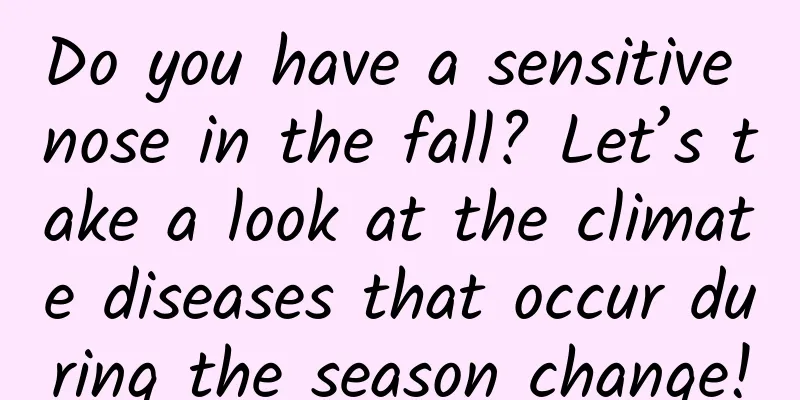Do you have a sensitive nose in the fall? Let’s take a look at the climate diseases that occur during the season change!

|
Right now, as the summer and autumn seasons change, many friends who are allergic to pollen have started to sneeze constantly, have dry and itchy eyes, and have a stuffy and runny nose... (including me, of course) Similarly, respiratory diseases such as colds and asthma are common during the season change. Why do “climate diseases” occur more frequently during seasonal transitions? Which meteorological factors in autumn are likely to cause diseases? What weather conditions are most conducive to the spread of allergens such as pollen? In recent years, meteorological departments in Beijing, Shanghai, Tianjin and other places have made many innovative explorations in healthy meteorology. Today, we invite experts to help you analyze it. Seasonal allergies? Don’t panic! Check out the allergy index! In spring and autumn every year, pollen and other allergens are produced in large quantities, which is the peak period for seasonal allergies! Beijing: Airborne allergenic pollen in Beijing mainly comes from Pinaceae, Cupressaceae, Salicaceae, Asteraceae, Moraceae Humulus, Chenopodiaceae, and Poaceae, accounting for more than 90% of the total pollen. In spring, Cupressaceae, Salicaceae, and Pinaceae are the main pollen species, while in summer and autumn (from June to October), Chenopodiaceae, Asteraceae, and Moraceae Humulus are the main pollen species. At present, the public can check these service products through Weibo "Weather Beijing" and WeChat public account "Pollen Monitoring and Forecasting" and mini program "Pollen Health Treasure", which is very convenient. During the peak pollen season, the above products will also be released on Beijing Satellite TV weather forecast program and "Weather Beijing" Douyin. Pollen Forecast Map Nearby allergens reminder Tianjin: Currently, Tianjin has entered the peak period of autumn pollen allergy. Compared with previous years, the outbreak of autumn pollen in Tianjin this year appeared relatively late. The main reason is that Tianjin had frequent rainfall in mid-to-late August this year. That is, when the pollen concentration is about to rise, the wet deposition of rainwater causes the pollen particles in the air to fall to the ground, thereby reducing the pollen concentration in the air. For example, in Jizhou, the actual pollen concentration is currently observed to be less than 50 grains/thousand square millimeters, which is significantly different from previous observations. ↑ Actual pollen monitoring situation in Jizhou from August 1 to September 3, 2021. ↑ Actual pollen monitoring situation in Jizhou from August 1 to September 3, 2020. (Note: In the figure, the green data indicates pollen concentration is less than 50 grains/1000 square millimeters, the yellow data indicates 51-100 grains/1000 square millimeters, the blue data indicates 101-200 grains/1000 square millimeters, and the red data indicates more than 200 grains/1000 square millimeters.) Recently, the Tianjin Meteorological Department will add pollen forecasts to the daily weather forecast text messages to remind susceptible people to take precautions. At the same time, the public can view the previous day's pollen concentration and the next day's pollen index forecast on the "Tianjin Meteorological" Weibo, WeChat, and client platforms. In addition, the public can also view relevant pollen concentration forecast audio and video programs through the "Tianjin Warning Release" Douyin account and Himalaya Audio account. Daily forecast SMS Public account pollen forecast As you can see, the main culprit for autumn allergies is actually pollen! What, there is pollen in autumn? Here is a little science tip! Of course there is pollen in the fall! Most of the pollen in spring comes from bright flowers, most of which are insect-pollinated flowers, which rely on insects for pollination. The pollen particles of insect-pollinated flowers are relatively large, and the pollen is easy to settle after falling off the flowers, and is less likely to be blown away by the wind; the amount of pollen is also relatively small. Therefore, large flowers cause relatively few allergies. Pollen in autumn mainly comes from inconspicuous grasses such as Artemisia, Chenopodiaceae, and Humulus. They are strong and can be found everywhere in the wilderness, fields, and community yards. These grasses also have very small flowers, which are called wind-pollinated flowers, that is, pollination is completed by wind. The pollen particles of wind-pollinated flowers are small and dry, and are easily dispersed in the wind; and there are more wind-pollinated flowers, and the pollen is small and abundant, which is more likely to cause allergies. During the day, the pollen concentration is relatively high from 10:00 to 17:00. However, sometimes a heavy rain will cause the pollen concentration to settle, so the pollen concentration observed after the rain will be relatively low. In other words, clear, breezy, and high-temperature weather is conducive to an increase in pollen concentration; significant rainfall and wind speeds above level 4 help to reduce pollen concentration. What is the meteorological department researching regarding healthy meteorology? Beijing: Beijing began monitoring pollen concentration in the city in 1988, carried out manual observation and forecasting services for pollen concentration in 1997, and officially started forecasting services in 1998. In 2012, the meteorological department and Beijing Tongren Hospital began to conduct pollen observations by type and subject. Based on historical data statistics and the use of accumulated temperature phenological models, the Beijing Meteorological Bureau simulated the forecast of the main airborne allergenic pollen periods in Beijing, and successively carried out forecasts for the beginning, peak and ending periods of pollen in the Pinaceae, Cupressaceae, Salicaceae, Asteraceae, Moraceae and Chenopodiaceae, as well as forecasts for the beginning, ending and length of the pollen season. It also collaborated with Beijing Tongren Hospital to produce visual products to provide pollen allergy prevention tips. Meteorological staff conduct pollen observation. Photo by Dai Jian In addition to pollen concentration forecasts, the Beijing Meteorological Department has also developed many forecast products that are close to the lives of citizens, such as car wash index, ultraviolet index, heat stroke index, wind chill index and more than 10 other index forecasts. The meteorological department has established regular cooperation with health departments and hospitals to provide meteorological services based on seasonal weather characteristics. For example, it cooperated with the Beijing Center for Disease Control and Prevention to jointly release the mosquito bite index forecast for the first time this year. Shanghai: In the past ten years, the Shanghai Meteorological Department has explored the relationship between weather climate, air pollution and respiratory diseases such as the common cold, childhood asthma and chronic obstructive pulmonary disease (COPD) through population epidemiological and toxicological experimental studies, and developed meteorological environmental risk forecasting technology for the above diseases in Shanghai. Since 2019, the Shanghai Meteorological Bureau has cooperated with the Pudong New Area Center for Disease Control and Prevention, the School of Public Health of Fudan University, and 48 community health service centers to explore and launch a closed-loop health meteorological service of "health risk prediction + doctor intervention + effect evaluation" for more than 4,800 community COPD patients: When cooling and polluted weather is approaching, the meteorological department provides COPD risk forecast information to COPD patients through WeChat, voice calls, and text messages; Community doctors provide health guidance to COPD patients based on forecast information; After nearly half a year of epidemiological intervention research, it was found that the COPD risk forecast that combines "disease meteorological risk reminders and doctor health guidance" has a positive effect on preventing the occurrence and development of COPD and reducing medical insurance expenses. ↑COPD meteorological environment risk forecast product launched by Shanghai Meteorological Department. Over the years, Shanghai Meteorological Department and Health Department have carried out scientific research around the impact of weather and climate, atmospheric environment on diseases and their mechanisms, as well as health risk forecasting and warning, and gradually established a sharing mechanism for health big data and meteorological big data to provide early forecasts and warnings for health risks that may be caused by adverse weather conditions. Risk forecasting services for meteorologically sensitive diseases such as heat stroke and respiratory diseases are routinely carried out in many schools, hospitals, elderly service agencies, and outdoor work units. ↑The children's asthma meteorological environmental risk forecast product launched by the Shanghai Meteorological Department. Tianjin: At present, Tianjin Environmental Meteorological Center has developed eight health meteorological indexes based on statistical methods and models, accounting for about half of the commonly used indexes. These indexes include: pollen index, cold index, carbon monoxide poisoning, heat stroke index, intestinal infection index, etc. Jizhou District Meteorological Bureau autumn pollen monitoring. This year, Tianjin has focused on building a "metropolitan health meteorological service system" to build a forecast and warning business and technology support platform around the meteorological risk forecast and warning service goals for typical meteorological sensitive diseases such as stroke, asthma, and influenza. In particular, in view of the aging population and severe chronic disease situation and high incidence of stroke in Tianjin, we have developed meteorological risk warning technology for stroke, and will release relevant meteorological risk warning products in due course in the autumn and winter of this year. In addition, the development of healthy meteorological services requires data support from both meteorological and medical aspects. The Tianjin Meteorological Bureau and the Second Hospital of Tianjin Medical University took the lead in establishing the Tianjin Healthy Meteorological Cross-Innovation Center with the participation of relevant universities and enterprises, and made efforts from multiple parties to continuously carry out scientific research and exploration. Conclusion Speaking of healthy weather, it has been related to ancient my country. The famous medical book "Huangdi Neijing" has long had the essence of the idea of "not treating existing diseases but preventing them". It aims to take the pulse of weather changes, capture risks in advance for sensitive diseases that are easily affected by meteorological factors and air pollution, and improve the public's risk prevention and control capabilities for meteorologically sensitive diseases. It is currently a period of seasonal change, with large temperature fluctuations, which can easily induce colds, respiratory infections, cardiovascular and cerebrovascular diseases, etc. Please pay attention to the weather forecasts and warnings pushed by the meteorological department, and the health weather service tips, and respond calmly to weather changes! Produced by China Meteorological News Agency Planning: Zhang Juan Author: Zhang Juan, Peng Li, Ye Fanglu, Zhang Yan, Yuan Chao, Fan Wenyan Expert Advisor: Peng Li, Chief Engineer of Shanghai Environmental Meteorological Center and Academic Leader of Health Meteorological Laboratory Ye Caihua, deputy director of Beijing Meteorological Service Center Fan Wenyan, deputy director of the Environmental Forecasting Section of Tianjin Environmental Meteorological Center Yuan Chao, deputy chief of the early warning service section of Tianjin Emergency Public Event Early Warning Information Release Center Image source: Beijing Meteorological Bureau, Shanghai Meteorological Bureau, Tianjin Meteorological Bureau References: China Meteorological Network, Xinmin Evening News, China National Radio, etc. Editor: Zhang Juan Review: Duan Haoshu |
<<: What kind of fish is sardine? What is the difference between sardine and saury?
Recommend
Why smoking is more harmful to women than men
We all know that smoking is extremely harmful to ...
How to treat genital warts in women
Both men and women can suffer from genital warts,...
What should I do if there is a small fleshy lump next to my nipple?
Women’s nipples are very fragile and need special...
What novel is "Snow Pear Stewed in Rock Sugar" based on? Where can I read the novel "Snow Pear Stewed in Rock Sugar"?
With the extension of the holiday, more and more ...
What signals appear in your body indicate that your heart is asking you for help?
Reviewer of this article: Chen Haixu, Deputy Dire...
What are the early symptoms of cervical cancer?
Cancer is usually divided into early, middle and ...
Why does my butt hurt after pregnancy?
After pregnancy, the hormones in the pregnant wom...
Abdominal pain four days after abortion
As people's minds gradually open up, some wom...
Can women do moxibustion at night?
With the accelerated pace of life, many wage earn...
Can exercise relieve menstrual cramps?
Menstruation is a woman’s best friend every month...
Cervical bleeding when touched by cotton swab
Gynecological diseases are diseases that trouble ...
There is gray-brown color below when menstruation is not coming
The menstruation of a normal person should be bri...
What should I do if blisters grow on the female vulva? It needs to be solved correctly
In daily life, if people do not pay much attentio...
Iodine plays an important role in the synthesis of thyroid hormones! Doctors recommend: Supplement correctly to avoid harm
Iodine is one of the essential trace elements for...
What are the symptoms of hernia in women
Hernias are relatively common in children. But di...









